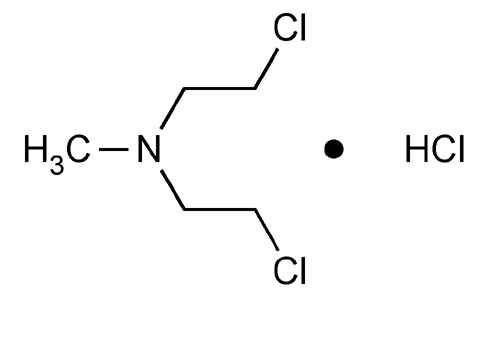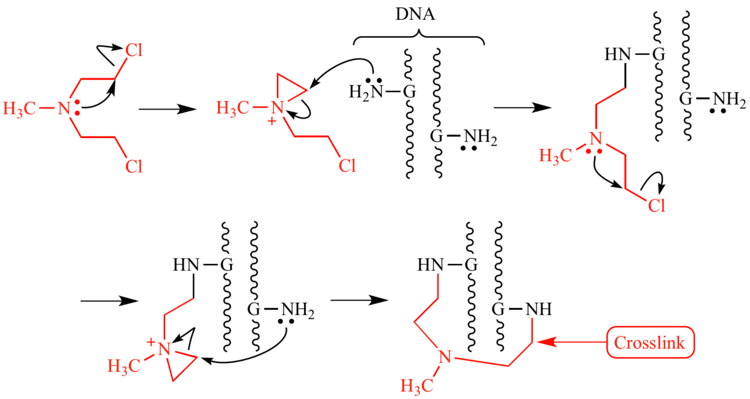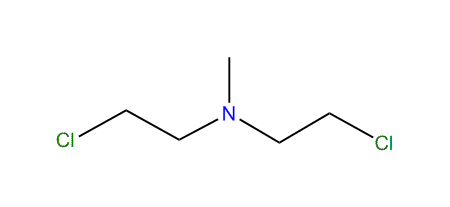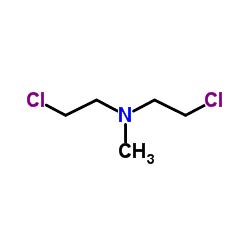Molar mass 156.05 g/mol Appearance Colorless liquid | CAS ID 51-75-2 | |
 | ||
Related amines | ||
The impact of drug shortages on children with cancer the example of mechlorethamine
Chlormethine (INN, BAN), mechlorethamine (widely used in the US, not the USAN, however) also known as mustine and HN2 and in former USSR known as Embichin is a nitrogen mustard sold under the brand name Mustargen. It is the prototype of alkylating agents, a group of anticancer chemotherapeutic drugs. It works by binding to DNA, crosslinking two strands and preventing cell duplication. It binds to the N7 nitrogen on the DNA base guanine. As the chemical is a blister agent, its use is strongly restricted within the Chemical Weapons Convention where it is classified as a Schedule 1 substance.
Contents
- The impact of drug shortages on children with cancer the example of mechlorethamine
- Uses
- Side effects and toxicity
- History
- Chemistry
- References

Mechlorethamine belongs to the group of nitrogen mustard alkylating agents.
Uses

It has been derivatized into the estrogen analogue estramustine phosphate, used to treat prostate cancer. It can also be used in chemical warfare where it has the code-name HN2. This chemical is a form of nitrogen mustard gas and a powerful vesicant. Historically, some uses of mechlorethamine have included lymphoid malignancies such as Hodgkin’s disease, lymphosarcoma, chronic myelocytic leukemia, polycythemia vera, and bronchogenic carcinoma Mechlorethamine is often administered intravenously, but when compounded into a topical formulation it can also be used to treat skin diseases. There have been studies demonstrating that topical administration of mechlorethamine has efficacy in mycosis fungoides-type cutaneous T cell lymphoma.
Another important use of chlormethine is in the synthesis of meperidine.
Side effects and toxicity

Mechlorethamine is a highly toxic medication, especially for women who are pregnant, breastfeeding, or of childbearing age. At high enough levels, exposure can be fatal.

The adverse effects of mechlorethamine depend on the formulation. When used in chemical warfare, it can cause immunosuppression and damage to mucous membranes of the eyes, skin, and respiratory tract. Mucous membranes and damp or damaged skin are more affected by exposure to HN-2. Though symptoms of exposure are generally delayed, the DNA damage it causes occurs very quickly. More serious exposures cause symptoms to develop sooner. Eye symptoms develop first, in the first 1–2 hours (severe exposure) or 3–12 hours (mild to moderate exposure) followed by airway (2-6/12–24 hours) and skin symptoms (6–48 hours). Hot, humid weather shortens the latent (symptom-free) period.

Symptoms of toxic exposure to HN-2 vary based on the route of exposure. Eye exposure causes lacrimation (tear production), burning, irritation, itching, a feeling of grittiness or dryness, blepharospasm (spasms of the eyelid), and miosis (pinpoint pupils). More severe cases cause edema (swelling from fluid accumulation) in the eyelids, photophobia (extreme sensitivity to light), severe pain, corneal ulceration, and blindness.

Inhalation of chlormethine damages the upper and lower airways sequentially, with more severe exposures causing faster damage that afflicts lower parts of the respiratory tract. Early symptoms include rhinorrhea (runny nose), epistaxis (nosebleed), toneless voice, sneezing, barking cough, and dyspnea (in smokers and asthmatics). Later symptoms include pain in the nose/sinuses and inflammation of the airway. In severe cases, there may be epithelial necrosis throughout the respiratory tract, causing pseudomembrane formation, which can obstruct the airway. Pneumonia may develop and prove fatal.

Skin exposure mainly causes erythema (redness) and vesication (blistering) at first, but absorption through the skin causes systemic toxicity. In cases where more than 25% of the skin is affected, fatal exposure is likely to have occurred.
Though ingestion is uncommon, if mechlorethamine is swallowed it causes severe chemical burns to the gastrointestinal tract and concomitant nausea, vomiting, diarrhea, abdominal pain, and hemorrhage.
Long-term effects of acute or chronic chlormethine exposure are caused by damage to the immune system. White blood cell counts drop, increasing the risk of infection, and red blood cell and platelet counts may also drop due to bone marrow damage. Chronic eye infections may result from exposure, but blindness is temporary. Long-term effects on the respiratory system include anosmia (inability to smell), ageusia (inability to taste), inflammation, chronic infections, fibrosis, and cancer. Skin that has been damaged by HN2 can change pigmentation or become scarred, and may eventually develop cancer.
History
Successful clinical use of chlormethine (mechlorethamine) resulted in development of the field of anticancer chemotherapy, led by Cornelius P. Rhoads at Memorial Sloan-Kettering. The drug is a nitrogen-based analogue of mustard gas (which is sulfur-based) and was derived from chemical warfare research. Secret clinical trials of the agent for Hodgkin's disease and several other lymphomas and leukemias in humans began in December 1942. Because of wartime secrecy restrictions, it was not until 1946 that the results of these trials were published openly.
Chemistry
Chlormethine is combustible and under extreme conditions becomes explosive. It can react with metals to form gaseous hydrogen.
